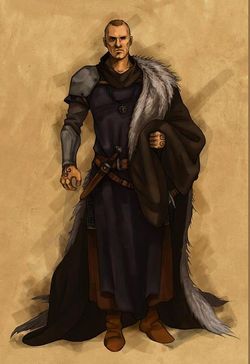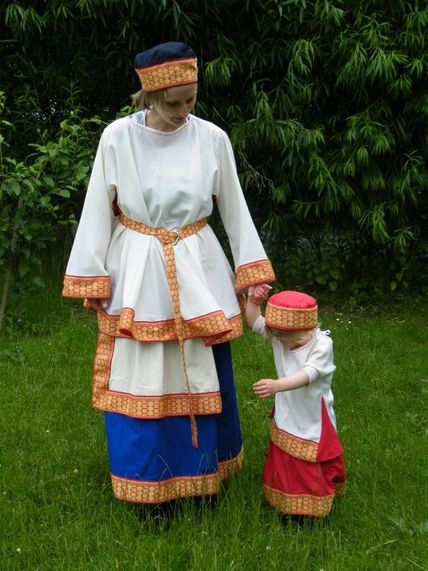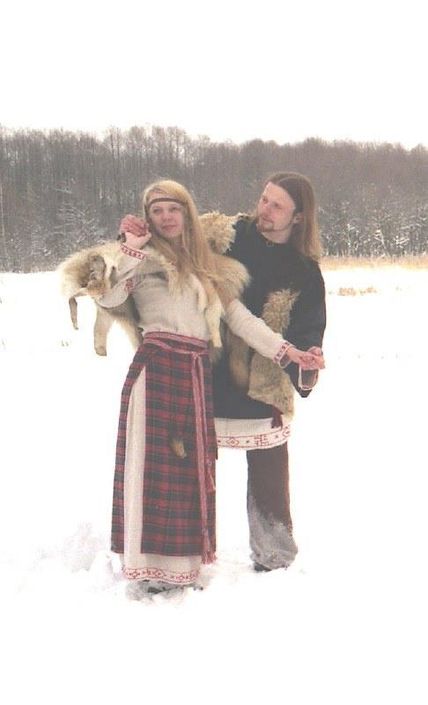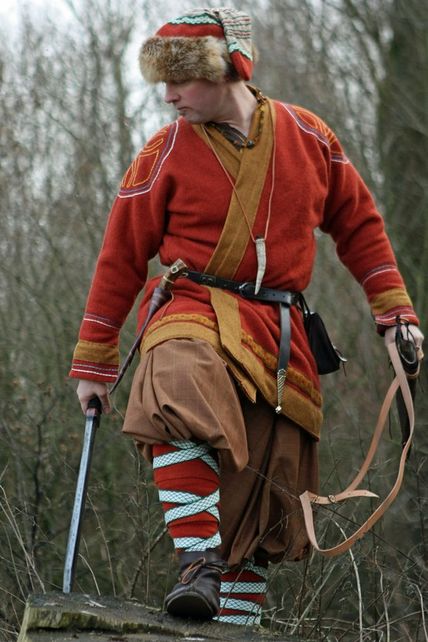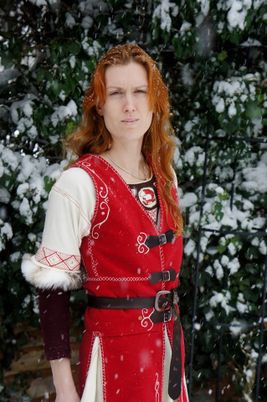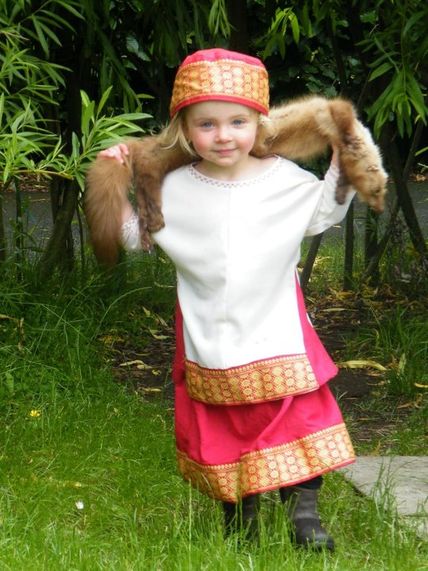Varushka look and feel
Wildwinter (talk | contribs) No edit summary |
|||
| Line 11: | Line 11: | ||
Rus and Slavic costume. | Rus and Slavic costume. | ||
===Materials=== | ===Materials=== | ||
Fabrics are usually a single colour, suitable for | Fabrics are usually a single colour, suitable for embroidery or decoration. Poorer Varushkans use practical and hard wearing materials like wool, | ||
felt, heavy cotton, leather - but the fabric is less important than the decoration. Fur is common, but is usually reserved for trim. | felt, heavy cotton, leather - but the fabric is less important than the decoration. Fur is common, but is usually reserved for trim. | ||
Revision as of 16:02, 20 July 2012
Overview
The land may be dangerous, but it is also rich. It is famous for its high quality furs, creating cloaks, robes and mantles in a range of colours and styles that mean many consider Varushkan fur the only fur to wear. Varushkan trees are another source of wealth. Timber is in high demand outside Varushka, and the Nation is home to many species of majestic hard woods. Amber is a common export, and many Varushkan men and women sport amber jewellery.
Feel
Dark, grim, fierce, durable, solid, resilient, wise, rich, decorated, warm 
Breakdown
Influences
Rus and Slavic costume.
Materials
Fabrics are usually a single colour, suitable for embroidery or decoration. Poorer Varushkans use practical and hard wearing materials like wool, felt, heavy cotton, leather - but the fabric is less important than the decoration. Fur is common, but is usually reserved for trim.
Colours
Bright vibrant colours predominate. A white shirt or dress is the most common under garment, with brightly decorated hems. Garments are made from cloth of a single colour, with contrasting colours being used for decoration and under garmets.
Clothing
The base layer is usually a white shirt or dress, with embroidered hems. Poor Varushkans use wool to stay warm, but most prefer to wear multiple layers of lighter clothing, often in contrasting colours. Warm shawls in bright colours are handed down through families.
Trousers for men and women have baggy legs that fall just above or below the knee with stockings bound to the leg beneath them. Women’s dresses have full, layered skirts and aprons.
Coats are more common that cloaks. The ideal coat has an asymmetric overlap across the chest, is nipped in at the waist but flares out below the waist to a full ‘skirt’. The wealthiest wear coats in bright strong colours often with fur trim or embroidered hems.
Decoration
Fur is used extensively to trim garments of all kinds including armour. Garmets are not made from decorative cloth or covered entirely in decoration, rather it is put in bands usually around the upper arms and the hems. Complex and detailed embroidery is the favourite, most commonly in brilliant red for a white garment. Smocking is common.
Jewellery
Amber and silver are most commonly worn. Hunters carry amulets, talismans and fetishes designed to protect them from the monsters that might otherwise hunt them in turn.
Armour
The most common armour is scale or lamellar, either leather or metal. Splinted greaves and vambraces are common. Helms usually rise to a point, often with a plume.
A few boyars wear plate that has a simple design but is intricately decorated. Plate can be tooled to emphasize the strength and power of the wearer and to make them appear darker and more intimidating.
Shields
Round shields are common and some Schlacta employ a pavisse.
Weapons
Schlacta, the Varushkan professional warriors, use heavy weapons of war such as broad swords, war axes and bardiches. The woodsman’s axe is a common weapon for many other Varushkans.
Icons and important Images
Animals in their roles as embodiment of the Imperial Virtues are common elements in Varushkan jewellery, heraldry and decoration. They are worn as belt buckles, symbols carved into the belt leather or charms and embroidered onto patches or into the decoration of a garment.
Symbols of warding are common, and take the form of eyes and faces that watch vigilantly for danger, stars and moons that represent the light that comes at night, images of torches and burning brands, and symbols of swords and shields that represent armed might. Some symbols of the Imperial Faith are used as well, especially the labyrinth which represents a hope that monsters will become lost and unable to find the bearer. Many Varushkans wear a talisman or amulet with a personal symbol that represents protection carved on it, and gifts of protective talismans are common between family members and lovers. The efficacy of these wardings is questionable if they are not supported by other magic, but they are often useful for inspiring confidence and reminding the bearer that they are not alone no matter how dark their situation might be.
Varushka loves dark bread and honey, and many meals start or end with it. Honey is also used to brew mead or create sweets, and bees are a powerful symbol of prosperity, wealth and the family.
Images
Basic costume
The most common Varushkan costume is a white shirt, tunic or dress, often white or a light colour. This is intricately embroidered on the hems, the most commonly in red but any bright contrasting colour is fine.
Garments may be made from wool, but most Varushkans prefer a lighter material like linen. These can be worn in layers for warmth commonly with different garmets in contrasting colours.
Low status costume
This couple are wearing some traditional Varushkan garmets, a white dress and a white tunic with embroidered hems respectively. Sheepskin is a practical but cheap material which is worn by poor Varushkans, wealthier individuals would layer their garments and hem them with fur. Patterned fabrics, such as the woman’s skirt, are used by the poor in place of the embroidered garments worn by most Varushkans. 
High status costume
The ideal Varushkan jacket is fitted on the arms and chest but flares out from the waist with a full “skirt” of material. Dark coloured garments may be trimmed with fur rather than embroidered. 
Trousers
Varushkans men and women wear plain coloured “hero trousers”. Ideally these should be baggy down to just past the knee. Anything worn below the knee should be strapped to the leg. Trousers may be plain or be brightly dyed but are usually made from fabric of a single colour, but the strapping is another opportunity for a bright contrasting colour, embroidery or both. 
Varushkan armour
The traditional Varurkan armour worn by the Schlacta, the professional soldiers, is tightly woven scale or lammellar. 
Varushkan armour is as likely to be leather as metal.
Varushkan Helms
The ideal Varushkan helm is pointed with a plume emerging from the point. 

Boyars
Boyars who are warriors often wear the traditional lammellar armour but with more complete coverage and supplemented with hardened leather or plate on the fore-arms and legs. 
Boyars are not sadistic tyrants, but their rule may be authoritarian, callous or even cruel. Some adopt an intimidating demeanour, the better to project their power and authority over their dominion. Warrior boyars who choose to fight the monsters of the dark forests by appearing as dark as their foes may wear a suit of plate fashioned that reflects the dark gothic tone of the nation.
Embroidery
The most distinctive feature of Varushkan costume is the intricate embroidery that provides a stark contrast. Embroidery should stand out and show off the wearer’s wealth. The entire garment should not be embroidered or decorated - the ideal placements are hems and in bands around the upper arm, but any garment will look more Varushkan with some embroidery. 
===Hats=== Varushkan hats may be simple embroidered round caps trimmed with fur or else pointed caps that fold over the head.
Children
Costume for Varushkan children follows the traditional styles and emphasis on bright colours.
Images to avoid - DO NOT USE THESE
A LRP setting is defined as much by what you leave out as by what you include. In defining the Varushkan look we have actively chosen to exclude some elements. Please do not use any of the images or looks seen in this section.
Hussars Jacket - DO NOT USE THESE
Hussars are too modern for the game and the Hussars jacket is not part of the Varushkan look. Varushkan wear full length coats not the short jackets favoured by cavalyrmen.
Please try to avoid frogging or tablat braiding across the chest that is so elaborate and intense that it evokes the Hussar image. Varushkan decoration is primarily embroidery and fur trim.
Thor’s Hammer - DO NOT USE THESE
Thor’s Hammers have become as evocative and iconic as a crucifix. They are irrevocably associated with Thor, a deity which does not exist in the Empire game setting, so please avoid this specific piece of jewellery.
Cossacks - DO NOT USE THESE
The Varushkan look is inspired by Rus and Slavic costume
and does not include Coassacks. We have excluded the Cossack look from the setting because like the Hussars it is evocative of a much later period than the game draws from. Please avoid elements that are reminiscent of cossacks; boots that rise to meet the trousers, small waistcoats, and cossack- style hats made entirely of fur. Please also avoid cossack dancing. It is iconic - for cossacks - but is not appropriate for Varushkans in Empire. 
